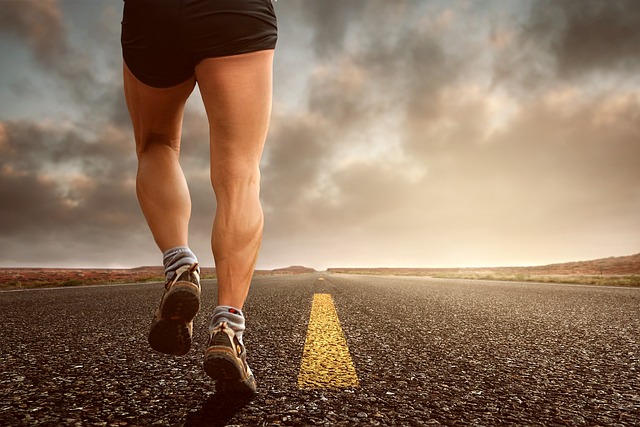
Knee pain while running
Did you know that knee pain can be related to the feet? Knee pain while running can develop from many different factors, but it can be caused or exaggerated from the way the feet are moving. When the feet move, the lower leg and upper leg respond in the same way.
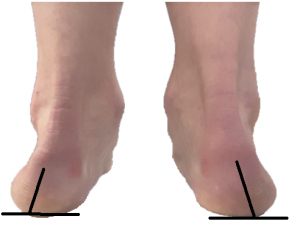
Flat feet/pronation and knee pain
Flat feet are when the arches on the inside of the feet are lower than normal. A flat foot can be completely flat on the ground, or a small arch can be present.
A flat foot changes the shock absorption properties and the way the legs respond. When the arch is low, the lower leg and upper leg rotate inwards. This changes the way the knee is moving and where the contact points are.
A subcategory of flat feet is pronation. Pronation is when the feet, ankles and/or heels roll inwards. How it differs from a flat foot, is that you can have a regular arch or a high arch while standing, and the foot, ankle and/or heel collapses inwards. Pronation can also occur in combination with a flat foot.
Pronation works in a similar way to flat feet. When then feet roll inwards, the lower and upper leg roll inwards as well.
As we run, these motions are exaggerated. While running, your feet and muscles need to control a much higher force. This means your foot motions tend to be much more exaggerated while running versus walking. Some people may notice their knee pain only while running, or the knee pain started after beginning a running program.
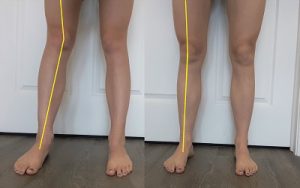 Knee joint pain (arthritis, meniscus)
Knee joint pain (arthritis, meniscus)
In the knee joint, discs called meniscus sit in the knee joint and protect the bones from wear and tear. There are two of these discs in each knee joint: one sits closer to the outside, while the other sits beside it on the inside. Normally, there is about equal pressure between the outside disc and the inside disc. When the lower and upper leg rotate in from a flat foot, there is more pressure on the outside of the knee joint. Overtime, the outside disc in the knee joint can wear down and lead to pain.
Ligaments
While the outside of the knee joint has increased pressure, the inside of the knee is opening up more. Because the joint spreads out more, the ligaments connecting the thigh bone and the shin bone can become stretched.
PFPS (patellofemoral pain syndrome)
When the knee is rolling inwards from the feet, the knee cap may not be tracking properly. The bones are rotating inwards while the muscles are pulling the knee cap outwards. There are more muscles at the knee cap pulling it outwards than there is pulling it in. The combination of the knee cap pulling outwards and the leg bones rotating inwards, can create pain from the knee cap rubbing on grooves that are not intended for the knee cap to run over.
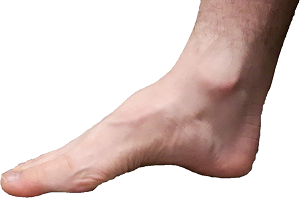 High arches/supination and knee pain
High arches/supination and knee pain
High arches can also lead to knee pain. Knee pain from high arches can develop due to a lack of shock absorption. While running, the foot should be absorbing most of the shock through slight pronation (rolling in). If the foot is not absorbing the shock during the initial contact with the ground, the shock needs to be absorbed elsewhere. In some cases, the knee will absorb this shock and lead to pain.
Supination is when the foot, heel and/or ankle rolls outwards. When the foot, heel or ankle rolls outwards, the lower and upper leg rotate outwards as well. This causes abnormal pressure and strain at the knee joint.
Theses motions can be noticed much more while running. You may also notice that the feet act
much differently running versus walking. This can be due to muscle imbalances and compensations.
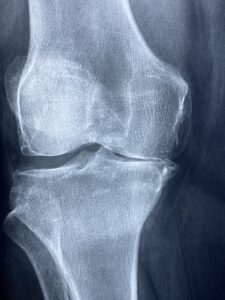 Knee joint pain (arthritis, meniscus)
Knee joint pain (arthritis, meniscus)
With high arches and/or supination, the knee pain in the joint works in the opposite way to pronation. When the lower and upper leg rotate outwards, there is more pressure on the inside of the knee joint. Overtime, the inside disc in the knee joint can wear down and lead to pain.
Ligaments
While the inside of the knee joint has increased pressure, the outside of the knee is opening up more. Because the joint spreads out more, the ligaments connecting the thigh bone and the shin bone can become stretched.
PFPS (patellofemoral pain syndrome)
When the knee is rolling outwards from the feet, the knee cap may not be tracking properly. If the muscles are imbalanced around the knee, this can exaggerate motion at the knee cap when combined with a high arch/supination.
Conclusion
The way your feet are moving can make an impact on knee pain, especially while running. Your feet are a good place to look at as it can affect the structures higher up the body.
If you have any questions, feel free to contact us or book an appointment.

You must be logged in to post a comment.